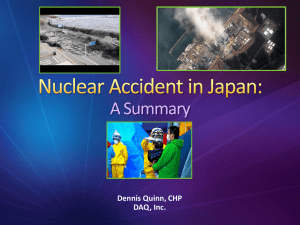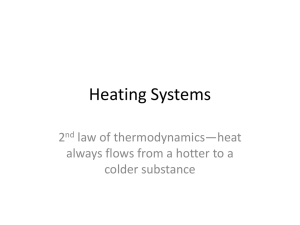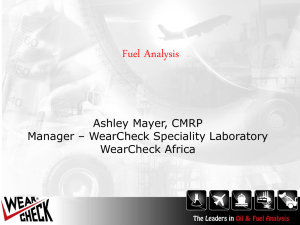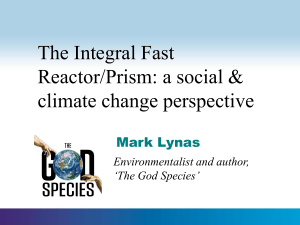Sodium Cooled Fast Reactor for TRU Recycling
advertisement
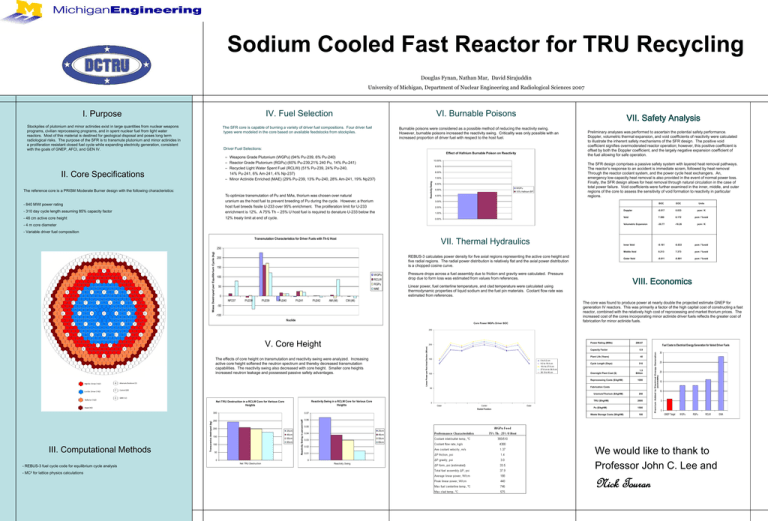
Sodium Cooled Fast Reactor for TRU Recycling Douglas Fynan, Nathan Mar, David Sirajuddin University of Michigan, Department of Nuclear Engineering and Radiological Sciences 2007 IV. Fuel Selection I. Purpose Stockpiles of plutonium and minor actinides exist in large quantities from nuclear weapons programs, civilian reprocessing programs, and in spent nuclear fuel from light water reactors. Most of this material is destined for geological disposal and poses long term radiological risks. The purpose of the SFR is to transmute plutonium and minor actinides in a proliferation resistant closed fuel cycle while expanding electricity generation, consistent with the goals of GNEP, AFCI, and GEN IV. VI. Burnable Poisons The SFR core is capable of burning a variety of driver fuel compositions. Four driver fuel types were modeled in the core based on available feedstocks from stockpiles. VII. Safety Analysis Burnable poisons were considered as a possible method of reducing the reactivity swing. However, burnable poisons increased the reactivity swing. Criticality was only possible with an increased proportion of driver fuel with respect to the host fuel. Driver Fuel Selections: Effect of Hafnium Burnable Poison on Reactivity – Weapons Grade Plutonium (WGPu) (94% Pu-239, 6% Pu-240) – Reactor Grade Plutonium (RGPu) (60% Pu-239,21% 240 Pu, 14% Pu-241) – Recycled Light Water Spent Fuel (RCLW) (51% Pu-239, 24% Pu-240, 14% Pu-241, 6% Am-241, 4% Np-237) – Minor Actinide Enriched (MAE) (29% Pu-239, 13% Pu-240, 28% Am-241, 19% Np237) 8.00% 7.00% The reference core is a PRISM Moderate Burner design with the following characteristics: - 310 day cycle length assuming 85% capacity factor To optimize transmutation of Pu and MAs, thorium was chosen over natural uranium as the host fuel to prevent breeding of Pu during the cycle. However, a thorium host fuel breeds fissile U-233 over 95% enrichment. The proliferation limit for U-233 enrichment is 12%. A 75% Th – 25% U host fuel is required to denature U-233 below the - 46 cm active core height 12% treaty limit at end of cycle. - 840 MWt power rating The SFR design comprises a passive safety system with layered heat removal pathways. The reactor’s response to an accident is immediate scram, followed by heat removal Through the reactor coolant system, and the power cycle heat exchangers. An, emergency low-capacity heat removal is also provided in the event of normal power loss. Finally, the SFR design allows for heat removal through natural circulation in the case of total power failure. Void coefficients were further examined in the inner, middle, and outer regions of the core to assess the sensitivity of void formation to reactivity in particular regions. 9.00% Reactivity Swing II. Core Specifications 10.00% 6.00% WGPu 5.00% Preliminary analyses was performed to ascertain the potential safety performance. Doppler, volumetric thermal expansion, and void coefficients of reactivity were calculated to illustrate the inherent safety mechanisms of the SFR design. The positive void coefficient signifies overmoderated reactor operation; however, this positive coefficient is offset by both the Doppler coefficient, and the largely negative expansion coefficient of the fuel allowing for safe operation. 10% Hafnium BP 4.00% 3.00% BOC EOC Units Doppler -0.017 0.033 pcm / K Void 7.380 6.172 pcm / %void Volumetric Expansion -30.77 -18.26 pcm / K Inner Void -0.161 -0.033 pcm / %void Middle Void 8.213 7.373 pcm / %void Outer Void -0.611 -0.801 pcm / %void 2.00% 1.00% 0.00% 1 - 4 m core diameter - Variable driver fuel composition VII. Thermal Hydraulics Transmutation Characteristics for Driver Fuels with Th-U Host Mass Destroyed per Equilibrium Cycle (kg) 250 REBUS-3 calculates power density for five axial regions representing the active core height and five radial regions. The radial power distribution is relatively flat and the axial power distribution is a chopped cosine curve. 200 150 WGPu 100 RCLW RGPu 50 MAE 0 NP237 PU238 PU239 PU240 PU241 PU242 AM (All) Pressure drops across a fuel assembly due to friction and gravity were calculated. Pressure drop due to form loss was estimated from values from references. VIII. Economics Linear power, fuel centerline temperature, and clad temperature were calculated using thermodynamic properties of liquid sodium and the fuel pin materials. Coolant flow rate was estimated from references. CM (All) The core was found to produce power at nearly double the projected estimate GNEP for generation IV reactors. This was primarily a factor of the high capital cost of constructing a fast reactor, combined with the relatively high cost of reprocessing and market thorium prices. The increased cost of the cores incorporating minor actinide driver fuels reflects the greater cost of fabrication for minor actinide fuels. -50 -100 Nuclide Core Power WGPu Driver BOC 250 Linear Power per Rod Axial Section (W/cm) The effects of core height on transmutation and reactivity swing were analyzed. Increasing active core height softened the neutron spectrum and thereby decreased transmutation capabilities. The reactivity swing also decreased with core height. Smaller core heights increased neutron leakage and possessed passive safety advantages. Capacity Factor Plant Life (Years) 150 0 to 9.2 cm 9.2 to 18.4 cm 18.4 to 27.6 cm 27.6 cm to 36.8 cm 36. 8 to 46 cm 100 Cycle Length (Days) Overnight Plant Cost ($) Reprocessing Costs ($/kgHM) Uranium/Thorium ($/kgHM) Reactivity Swing in a RCLW Core for Various Core Heights Center 0.07 250 0.06 200 25cm 46cm 150 55cm 85cm 100 50 - MC2 for lattice physics calculations Net TRU Destruction 310 1.5 Billion 1000 250 TRU ($/kgHM) 2600 Outer Pu ($/kgHM) 1500 Waste Storage Costs ($/kgHM) 100 30 25 20 15 10 5 0 GNEP Target WGPu RGPu RCLW 0.05 25cm 0.04 46cm 55cm 0.03 85cm 0.02 0.01 0 0 - REBUS-3 fuel cycle code for equilibrium cycle analysis Reactivity Swing in percent keff III. Computational Methods Transuranics destroyed (kg) Radial Position 300 40 0 Outer Fuel Costs to Electrical Energy Generation for Varied Driver Fuels 0.9 Fabrication Costs 50 Net TRU Destruction in a RCLW Core for Various Core Heights 288.87 Premium Added to Electrical Energy Generation (mill/kWh) V. Core Height Power Rating (MWe) 200 Reactivity Swing We would like to thank to Professor John C. Lee and Nick Touran EMA
